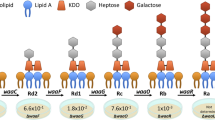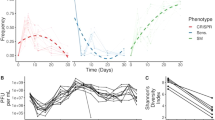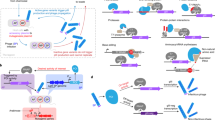Abstract
Bioengineering advances have made it possible to fundamentally alter the genetic codes of organisms. However, the evolutionary consequences of expanding an organism's genetic code with a noncanonical amino acid are poorly understood. Here we show that bacteriophages evolved on a host that incorporates 3-iodotyrosine at the amber stop codon acquire neutral and beneficial mutations to this new amino acid in their proteins, demonstrating that an expanded genetic code increases evolvability.
This is a preview of subscription content, access via your institution
Access options
Subscribe to this journal
Receive 12 print issues and online access
$259.00 per year
only $21.58 per issue
Buy this article
- Purchase on Springer Link
- Instant access to full article PDF
Prices may be subject to local taxes which are calculated during checkout


Similar content being viewed by others
Accession codes
Primary accessions
Sequence Read Archive
Referenced accessions
NCBI Reference Sequence
Protein Data Bank
References
Crick, F.H.C. J. Mol. Biol. 38, 367–379 (1968).
Knight, R.D., Freeland, S.J. & Landweber, L.F. Nat. Rev. Genet. 2, 49–58 (2001).
Ambrogelly, A., Palioura, S. & Söll, D. Nat. Chem. Biol. 3, 29–35 (2007).
Freeland, S.J. & Hurst, L.D. J. Mol. Evol. 47, 238–248 (1998).
Itzkovitz, S. & Alon, U. Genome Res. 17, 405–412 (2007).
Liu, C.C. & Schultz, P.G. Annu. Rev. Biochem. 79, 413–444 (2010).
Davis, L. & Chin, J.W. Nat. Rev. Mol. Cell Biol. 13, 168–182 (2012).
Brustad, E.M. & Arnold, F.H. Curr. Opin. Chem. Biol. 15, 201–210 (2011).
Wang, K., Neumann, H., Peak-Chew, S.Y. & Chin, J.W. Nat. Biotechnol. 25, 770–777 (2007).
Bacher, J.M., Hughes, R.A., Tze-Fei Wong, J. & Ellington, A.D. Trends Ecol. Evol. 19, 69–75 (2004).
Ohtake, K. et al. J. Bacteriol. 194, 2606–2613 (2012).
Dunn, J.J. & Studier, F.W. J. Mol. Biol. 166, 477–535 (1983).
Molineux, I.J. The Bacteriophages 277–301 (Oxford UP, 2006).
Bull, J.J. et al. Genetics 147, 1497–1507 (1997).
Bull, J.J., Badgett, M.R., Rokyta, D. & Molineux, I.J. J. Mol. Evol. 57, 241–248 (2003).
Chan, L.Y., Kosuri, S. & Endy, D. Mol. Syst. Biol. 1, 2005.0018 (2005).
Sakamoto, K. et al. Structure 17, 335–344 (2009).
Mukai, T. et al. Biochem. Biophys. Res. Commun. 411, 757–761 (2011).
Tabor, S. & Richardson, C.C. J. Biol. Chem. 264, 6447–6458 (1989).
Cheetham, G.M. & Steitz, T.A. Science 286, 2305–2309 (1999).
Wang, I.N., Smith, D.L. & Young, R. Annu. Rev. Microbiol. 54, 799–825 (2000).
Wang, N., Dykhuizen, D. & Slobodkin, L. Evol. Ecol. 10, 545–558 (1996).
Heineman, R.H., Bull, J.J. & Molineux, I.J. Mol. Biol. Evol. 26, 1289–1298 (2009).
Lajoie, M.J. et al. Science 342, 357–360 (2013).
Moe-Behrens, G.H.G., Davis, R. & Haynes, K.A. Front. Microbiol. 4, 5 (2013).
Dodt, M., Roehr, J., Ahmed, R. & Dieterich, C. Biology 1, 895–905 (2012).
Gfeller, D., Michielin, O. & Zoete, V. Nucleic Acids Res. 41, D327–D332 (2013).
Young, D.D., Jockush, S., Turro, N.J. & Schultz, P.G. Bioorg. Med. Chem. Lett. 21, 7502–7504 (2011).
Shevchenko, A., Tomas, H., Havlis, J. & Olsen, J. Nat. Protoc. 1, 2856–2860 (2006).
Acknowledgements
We thank J. Bull, I. Molineux, R. Hughes, C. Barnhart, D. Deatherage, R. Alnahhas, M. Schmerer, A. Miklos, A. Meyer and A. Maranhão (all at the University of Texas at Austin) for plasmids, strains, advice and technical assistance. The RF0 IodoY strain was provided by RIKEN and by the Targeted Proteins Research Program, the Ministry of Education, Culture, Sports, Science and Technology, Japan. We acknowledge the Texas Advanced Computing Center (TACC) at The University of Texas at Austin for providing HPC resources. This research was supported by the US National Institutes of Health (NIH) (R00-GM087550 to J.E.B.), the US National Science Foundation (NSF) BEACON Center for the Study of Evolution in Action (DBI-0939454 to J.E.B.), the US Army Research Office (W911NF-12-1-0390 to J.E.B. and E.M.M.), the US National Security Science and Engineering Faculty (FA9550-10-1-01-69 to A.D.E.), the US Defense Advanced Research Project Agency (HR-0011-12-C-0066 to A.D.E.) and the NSF (MCB-0943383 to A.D.E.). E.M.M. also acknowledges funding from the NIH, the NSF, the Cancer Prevention Research Institute of Texas and the Welch Foundation (F1515).
Author information
Authors and Affiliations
Contributions
M.J.H., J.W.E., J.E.B. and A.D.E. conceived the study. M.J.H. performed evolution experiments. J.E.B. and M.J.H. analyzed sequencing data. M.J.H. and J.W.E. created RF0 Tyr and characterized phage lysis times. D.R.B and E.M.M. analyzed proteomics data. J.E.B. performed statistical analyses. J.E.B., M.J.H., J.W.E. and D.R.B. created figures and wrote the manuscript. All of the authors designed experiments and edited the manuscript.
Corresponding author
Ethics declarations
Competing interests
The authors declare no competing financial interests.
Supplementary information
Supplementary Text and Figures
Supplementary Results, Supplementary Figures 1–10 and Supplementary Tables 1 and 2. (PDF 5289 kb)
Supplementary Data Set 1
Mutations in bacteriophage samples. (XLSX 99 kb)
Supplementary Data Set 2
Informative peptide-spectrum matches. (XLSX 22 kb)
Rights and permissions
About this article
Cite this article
Hammerling, M., Ellefson, J., Boutz, D. et al. Bacteriophages use an expanded genetic code on evolutionary paths to higher fitness. Nat Chem Biol 10, 178–180 (2014). https://doi.org/10.1038/nchembio.1450
Received:
Accepted:
Published:
Issue Date:
DOI: https://doi.org/10.1038/nchembio.1450
This article is cited by
-
The developing toolkit of continuous directed evolution
Nature Chemical Biology (2020)
-
Evolving Bacterial Fitness with an Expanded Genetic Code
Scientific Reports (2018)
-
Expanding and reprogramming the genetic code
Nature (2017)
-
Crystal structures reveal an elusive functional domain of pyrrolysyl-tRNA synthetase
Nature Chemical Biology (2017)
-
Addicting diverse bacteria to a noncanonical amino acid
Nature Chemical Biology (2016)



